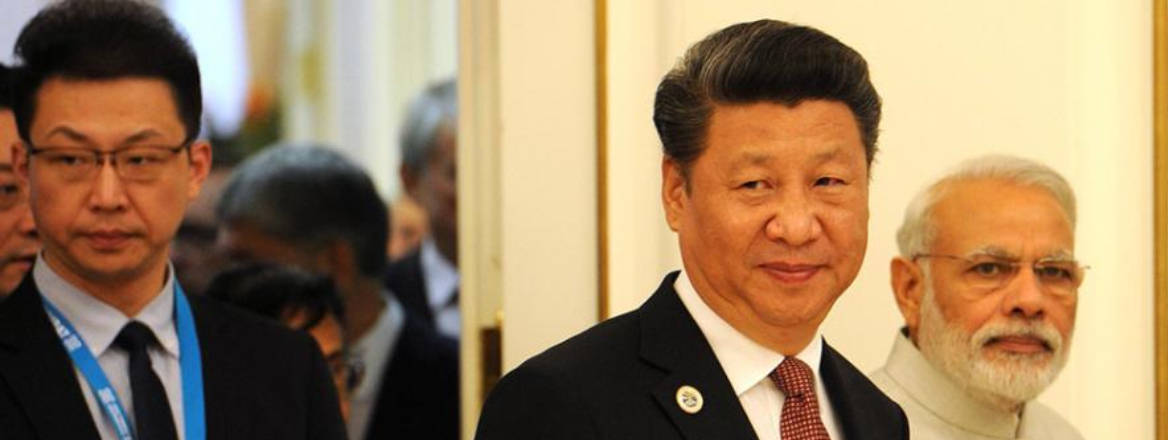Not the ‘Spirit of Wuhan’: Skirmishes Between India and China
What explains the occurrence of multiple confrontations between Indian and Chinese forces at disparate points along their disputed border?
On 5 May, India and Chinese patrols engaged in physical altercation along their disputed border, first near Pangong lake in Ladakh and again five days later in Sikkim, some 800 miles away. Normally such encounters are resolved by so-called ‘banner drills’: the defender holds their position and displays a series of signs in the other side’s language informing them they are trespassing and asking them to leave. In these cases, Chinese soldiers took a stronger line and attempted to force Indian troops back, first throwing rocks, later punches. Although both episodes were resolved without a resort to deadly force, this marked the third physical confrontation at Pangong Lake in as many years and the first time patrols had confronted each other in the Sikkim sector. Moreover, both sides have reportedly reinforced their positions in the dispute zones. Do these episodes signal broader challenges for Asia’s two nuclear giants?
Muddled Borders, Competing Interests
Colonial-era agreements and historical legacies have led China to assert that India’s northeastern state of Arunachal Pradesh – an area of more than 34,000 square miles – belongs to them, while India alleges that China occupies more than 14,000 square miles of Indian territory in the Aksai Chin along the eastern border of Ladakh. In addition, the poorly demarcated Line of Actual Control (LAC) separating the two countries runs for more than 2,000 miles across difficult terrain. Conception of the border’s exact location diverge in twenty separate places, creating numerous points of friction. Since the early 1980s, 22 rounds of talks have been held to resolve the border issue, but little progress has been made.
The Sino–Indian relationship is complicated. Economic ties between the two countries continue to grow. China is India’s second largest trading partner with bilateral trade surpassing $92 billion in 2019 – which some hope will lay the foundation for stable relations in the future.
Balancing this positive development, however, is long-standing friction: tensions over the two countries’ unresolved border disputes are not helped by China’s continued military support for Pakistan, nor their plans to construct the China–Pakistan Economic Corridor (CPEC) through disputed territory claimed by Delhi. India’s granting of sanctuary to the Dalai Lama and their hosting of the Tibetan government in exile remains a key source of mistrust from Beijing’s perspective, as is New Delhi’s burgeoning relationship with Washington and its steadfast refusal to join the Belt and Road Initiative (BRI). India and China are also at odds over China’s growing military and economic ties with the so-called small nations of South Asia, that India believes constitute – in not so many words – its sphere of influence. Even trade is a source of friction as India runs a trade deficit of more than $56 billion with China, largely exporting raw materials and importing manufactured goods. Finally, as India has increasingly sought some of the trappings of great power status – such as a seat on the UN security council or legitimisation of their nuclear program via membership in the Nuclear Suppliers Group – China has repeatedly emerged as an obstacle to the realisation of these ambitions.
In the summer of 2017, Indian and Chinese forces engaged in a 73-day standoff on the Doklam plateau over a border dispute between China and Bhutan, an episode that marked the most serious military crisis between the two countries in three decades. Narendra Modi and Xi Jinping subsequently met in a pair of ‘informal summits’ where the two leaders attempted to use their personal chemistry to ease tensions and reduce mutual suspicions. The two sides reportedly issued joint guidance to their militaries to manage differences on the border without raising tensions, but the face-to-face meetings failed to resolve any fundamental irritants in the bilateral relationship. Consequently, in the wake of the coronavirus pandemic, Indian public opinion of its neighbour has taken a sharp turn. As Tanvi Madan of the Brookings Institution has noted, ‘anti-China sentiment has gone mainstream in a way usually reserved for India’s other rival, Pakistan’.
Failure to improve relations post-Doklam is rooted in the fact that Chinese leaders have not seen India as a consequential actor they need to conciliate. Beijing’s effort to improve bilateral ties following Doklam were not motivated by feelings of genuine warmth. Indeed, by some accounts, Chinese leaders remain ‘profoundly suspicious of India’s strategic ambition and intentions’. Instead, the main objective in reaching out to Delhi was to prevent the deepening of a strategic partnership between India and the US that might present China with security challenges along its southwestern border while it is contesting US influence in the Western Pacific.
Pondering Pugilistic Patrols
What explains the occurrence of multiple confrontations between Indian and Chinese forces at disparate points along their disputed border at the same time? In trying to understand what is happening, we must be aware that the number of incidents where the encounters are serious enough to warrant media coverage, let alone lead to a physical altercation, is a fraction of the total number of episodes. Based on one study, of the number of border incidents recorded by the Indian government between 2010–14, only 1–2% received media coverage. Nevertheless, at least four possibilities emerge.
The first is that these actions are part of a concerted effort to distract attention from the Chinese government’s myriad of missteps and mask its weakness. Even before the coronavirus pandemic, Xi was already on the backfoot as international condemnation of Xinjiang concentration camps and BRI projects coincided with the Hong Kong protests and a dramatic slowdown of the Chinese economy. In the face of a dramatic downturn in China–US relations and a range of countries calling for Taiwan to be better integrated into international organisations, maintaining an image as a strong leader, as Minxin Pei has argued, is likely to be a top priority. Thus, it is possible that increased activity along the border is designed to send a message of Chinese resolve at a time of crisis to international observers, while conveying strength to domestic audiences. Indian analysts have certainly drawn a connection between increased Chinese pressure on Japan, Taiwan, the Philippines and Vietnam over their maritime disputes in East Asia and activities along the LAC. This thesis is somewhat undercut by recent research on Chinese coercion by Ketian Zhang who characterises Beijing as a ‘cautious bully’ who is hesitant to use force and one who takes the geopolitical implications of their actions into account. Pressing India militarily as a means of distracting domestic attention would seem to run counter to the avowed aim of keeping Delhi and Washington apart, particularly at a time when anti-Chinese sentiment in India is running so high. However, this could be a miscalculation on Beijing’s part that reflects the poor decision-making of Xi Jinping’s highly centralised system.
A second possibility is that these encounters are the product of local PLA commanders operating according to their own narrow operational considerations. In conducting more aggressive patrolling along the LAC they could be probing for tactical advantages without due consideration for the political or strategic effects of their actions. Alternatively, it might be the case that a new commander on the scene is seeking to make a name for himself via a tougher approach than his predecessor. There is some evidence that the PLA has initiated the use of force in past territorial disputes without the approval of the central government, including in the 1967 skirmishes with Indian forces on the Sikkim border that resulted in several hundred casualties. That being said, these episodes are few and far between historically and run contrary to contemporary understandings about how China is managing its territorial disputes in other domains, such as the South China Sea, where the actions of local military forces are tightly controlled and scripted. Moreover, it would appear to clearly disregard the instructions allegedly issued by Xi to avoid raising tension on the border.
Third, in recent years both China and India have been developing their military infrastructure in the vicinity of disputed areas. Thanks to better roads on their side of the LAC, Chinese patrols are vehicle-based while Indian troops travel on foot. Consequently, India’s Border Roads Organization has been building and upgrading transportation links in very difficult terrain to help ensure that ‘the Chinese no longer have free run in the area’. A better ability to patrol along the disputed boundary would presumably increase the number of encounters between Chinese and Indian patrols, but it does not necessarily explain why the scuffles ensued. Chinese state media sources have blamed India for the clashes, alleging they ‘built defensive fortifications and obstacles’ in Chinese territory as part of an effort to ‘unilaterally change the current border control situation’. The veracity of such claims should be subject to scrutiny given the source, however, they are in keeping with academic research on Chinese territorial disputes which suggest that the PLA is likely to respond forcibly to demonstrate resolve if they perceive an adversary is seeking to ‘increase the amount of disputed territory that it occupies or to improve its position in the local military balance’. If Indian road building is perceived as seeking to alter the status quo, the PLA may be authorised to respond more aggressively than they would otherwise.
The final explanation is that these encounters are simply a consequence of business as usual. Current and former Indian officials have been at pains to describe recent events as emblematic of ‘usual’ border tensions and brand the scuffles as ‘nothing new’. As the snow melts in the late spring, the two sides step up their patrolling along disputed zones and clashes occur. The former head of the Indo-Tibetan Border Police – the paramilitary force guarding the frontier with China – described Chinese attempts at slicing small portions of disputed territory as a regular ‘summer activity’ that has been going on for decades. Thus, the recent encounters might be seen as part of a consistent Chinese policy of opportunistically probing for weakness in disputed zones to test how far they can go without provoking a forceful response. As improbable as it might seem, the Commander of the Indian Army may be correct when he asserted, that ‘it is just a matter of chance’ that two standoffs happened in quick succession 800 miles apart. Nevertheless, it does not explain why the encounter at Sikkim took place – which is a settled international boundary – nor why the two countries have felt the need to dispatch reinforcements to the affected areas.
There are no unambiguous explanations for the recent dustup between India and China, nor are all of the justifications posited above necessarily mutually exclusive. What is clear, however, is that such episodes will be a constant feature of Sino–Indian relations until their border is finally demarcated.
Walter C Ladwig III is a Senior Lecturer in International Relations at King’s College London.
The views expressed in this Commentary are the author's, and do not represent those of RUSI or any other institution.
Dr Walter Ladwig
RUSI Associate Fellow, International Security


